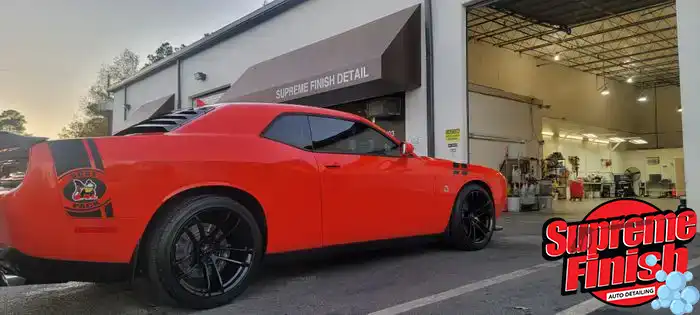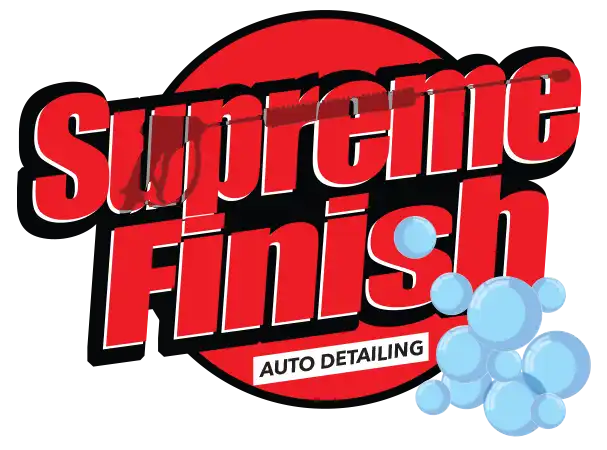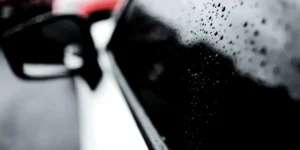Protect Your Vinyl Wrap with Ceramic Coating
“Can I apply a ceramic coating to vinyl wrap?” At our shop in Raleigh, we get this question all the time. Ceramic coatings are one of the most popular ways to protect a vehicle’s paint, thanks to their durability, hydrophobic properties, UV protection, and ease of maintenance. Meanwhile, vinyl wraps have also grown in popularity, giving car owners the ability to customize their vehicles while adding a layer of protection.
But can these two technologies work together? Is ceramic coating safe and effective for vinyl wraps? The short answer is yes—but there are some important factors to consider.
Let’s explore how ceramic coatings interact with vinyl wraps and whether this combination is worth the investment. If you have an existing vinyl wrap and want to discuss protecting it with a professional ceramic coating, feel free to contact Supreme Finish to learn more.
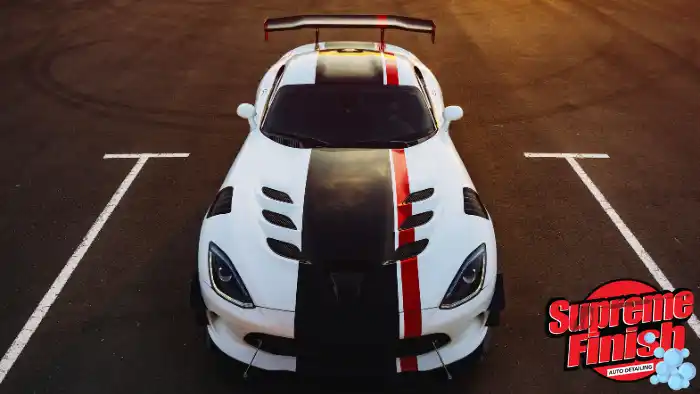
Understanding Ceramic Coatings
Before diving into how ceramic coatings work with vinyl wraps, it’s important to understand what ceramic coatings are and how they function.
What is Ceramic Coating?
A liquid polymer that chemically bonds to a surface, creating a durable, protective layer.
What are the Benefits of Ceramic Coating?
- Durability: Creates a hard, protective shell that resists contaminants and minor abrasions.
- Hydrophobic Properties: Repels water, dirt, and grime, making the surface easier to clean.
- UV Protection: Prevents oxidation and fading caused by sun exposure.
- Ease of Maintenance: Reduces the need for frequent washing and waxing.
What is a Vinyl Wrap?
Vinyl wraps are thin, adhesive-backed films that are applied over a vehicle’s original paint to change its appearance, add branding, or provide an extra layer of protection.
- Gloss – Mimics the look of glossy paint giving the vehicle a shiny, wet look.
- Matte – Creates a sleek, non-reflective finish popular with sports-car owners.
- Satin – A balance between gloss and matte with a soft sheen.
- Textured – Includes wraps like carbon fiber, brushed metal, or chrome finishes.
Can You Apply Ceramic Coating to Vinyl Wraps?
Yes, ceramic coatings can be applied to vinyl wraps, but the process is different from coating standard vehicle paint. If you want to ceramic coat a vinyl wrapped vehicle, we strongly recommend taking it to a professional coater like Supreme Finish.
Who Benefits Most from Ceramic Coating Vinyl Wrapped Cars?
- Daily Drivers – Protects against UV rays, road grime, and pollutants.
- Show Cars – Enhances gloss and appearance while keeping the wrap pristine.
- Fleet Vehicles – Makes maintenance easier and helps maintain a professional look.
- Luxury & Exotic Car Owners – Keeps high-end wraps looking flawless for longer.
Compatibility with Vinyl Wraps
- Ceramic coatings adhere well to vinyl wraps, just like they do to painted surfaces.
- The type of wrap affects the outcome—glossy wraps will appear even shinier, while matte wraps will retain their matte finish with added depth.
- Some coatings are designed specifically for vinyl, ensuring proper adhesion and flexibility.
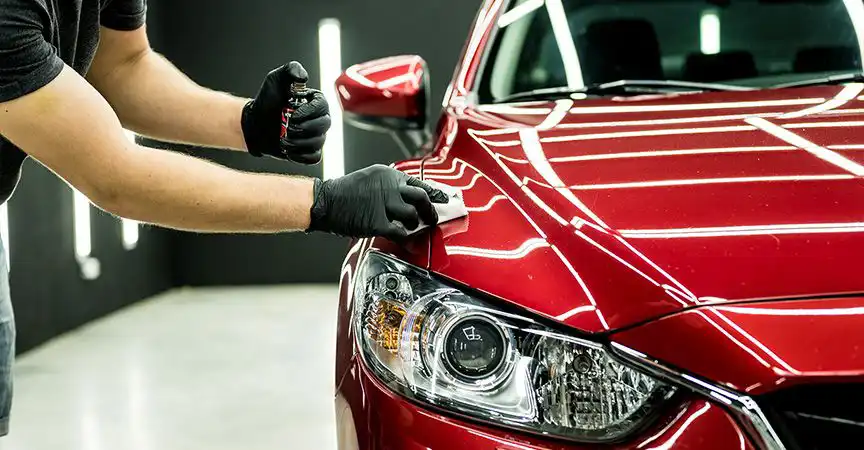
How Ceramic Coating Interacts with Wraps
- Gloss Wraps – Enhances shine and makes colors appear more vibrant.
- Matte & Satin Wraps – Does not add gloss, but increases richness and depth.
- Textured Wraps – May not bond as effectively due to irregular surfaces.
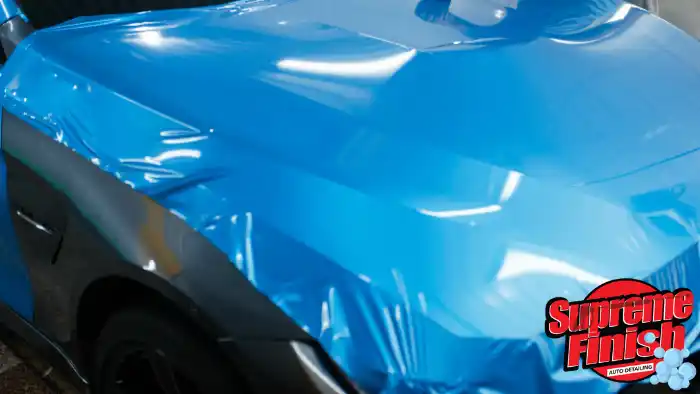
Potential Concerns
- Flexibility: Vinyl wraps are designed to be flexible, while ceramic coatings create a rigid layer. If not applied properly, the coating could reduce the wrap’s ability to stretch or reposition.
- Adhesion Issues: Some coatings may not bond well to textured or low-energy surfaces.
- Professional Application Recommended: Applying ceramic coating to vinyl requires careful prep work and the right product selection.

Benefits of Applying Ceramic Coating to Vinyl Wrap
By adding ceramic coating, you effectively protect your wrap from common damage and make it easier to maintain.
- Enhanced Protection – Shields against UV rays, oxidation, road contaminants, and stains.
- Hydrophobic Properties – Water, dirt, and grime bead off, making cleaning much easier.
- Extended Lifespan – Helps prevent fading, discoloration, and premature wear.
- Easier Maintenance – Reduces staining and eliminates the need for frequent washing.
- Enhanced Appearance – On gloss wraps, the shine is intensified. On matte and satin wraps, the finish retains its look but appears deeper and richer.
What is the Process for Applying Ceramic Coating to a Vinyl Wrap?
Applying ceramic coating to a vinyl wrap is a task that demands precision and patience, ensuring long-lasting protection and enhanced appearance.
DIY vs. Hiring a Professional
Decide if you’ll undertake this project yourself or hire a professional. DIY offers personal satisfaction and savings, but professionals bring experience and a guarantee. They ensure flawless application, minimizing risks.
Steps for DIY Application
-
Preparation: Begin by thoroughly cleaning the vinyl-wrapped surface, removing dirt, grime, and any previous waxes. A clean surface is crucial for the coating to adhere properly.
-
Gather Materials: Ensure you have all required materials on hand, such as microfiber cloths, applicator pads, and the ceramic coating itself.
-
Follow Instructions: Carefully read and adhere to the manufacturer’s instructions.
-
Applying the Coating: Use an applicator pad to apply a thin, even layer of ceramic coating.
Work in small sections to ensure even coverage and avoid missed spots. -
Curing the Coating: Allow the coating to cure according to the product’s directions. This step is essential as it solidifies the protective layer. Curing time can vary, but generally requires leaving the vehicle undisturbed for several hours or overnight.
- Final Buffing: Once cured, gently buff the surface with a clean microfiber cloth to remove any excess and achieve a glossy finish.
Importance of Proper Curing
The curing process is vital. Patience here ensures the coating forms a strong bond with the vinyl, enhancing both durability and appearance. Rushing can compromise the coating’s effectiveness, undermining your efforts.
In summary, although applying ceramic coating might seem straightforward, attention to detail and patience are imperative for optimal results. Whether you DIY or hire an expert, ensuring a meticulously followed process will yield the best protection for your vinyl wrap.
The Importance of Curing in Ceramic Coating for Vinyl Wraps
When it comes to applying ceramic coating to a vinyl wrap, the curing process is absolutely crucial. Whether you’re looking to protect the vibrant color of your wrap or extend its lifespan, allowing proper time for curing can make all the difference.
Why Curing Shouldn’t Be Overlooked
Enhanced Protection: The primary role of ceramic coating is to safeguard your vinyl wrap against environmental wear and tear. If you rush the curing process, the coating might not fully form its protective layer, leaving the wrap vulnerable to elements like UV rays, road debris, and acid rain.
Optimal Hydrophobic Properties: A fully cured ceramic coating achieves optimal hydrophobic properties. This means dirt and water will find it harder to cling to the surface, making maintenance a breeze.
Increased Durability: Proper curing ensures that the coating bonds well with the wrap, enhancing durability. This strong bond helps the coating withstand the daily challenges of driving and weather conditions.
Tips for Effective Curing
Follow Manufacturer’s Instructions: Each ceramic coating product might have different guidelines. Always adhere to the recommended curing times and conditions specified by the manufacturer.
Monitor Environmental Conditions: Temperature and humidity play a vital role in the curing process. Ideally, cure the coating in a controlled environment to avoid fluctuations that could impact the effectiveness of the coating.
Be Patient: While it might be tempting to get back on the road immediately, patience pays off. Taking the time to let your wrap cure properly ensures you’re getting the maximum benefits from your ceramic coating investment.
The curing process is not an optional step; it’s an essential one. Prioritizing it means you’re not just doing justice to the initial time and effort spent on applying the ceramic coating, but you’re also ensuring long-term protection and quality for your vinyl wrap.
Essential Aftercare and Maintenance for Ceramic-Coated Vinyl Wraps
Congratulations on getting that ceramic-coated vinyl wrap on your car! To keep your vehicle looking pristine and extend the life of its shiny finish, you’ll need to follow a few care strategies.
Regular Cleaning
Your first task is frequent cleaning. Use only pH-neutral car shampoos paired with soft cloths or sponges. This gentle approach avoids scratching the surface while maintaining the coating’s effectiveness.
Despite the ease that ceramic coating provides, it’s crucial not to neglect contaminants like bird droppings or tree sap. These should be removed promptly to avoid compromising the coating’s protective qualities.
Routine Checks and Quick Fixes
Regularly examine your car for any signs of wear or damage to the coating. Spotting weak points early allows for timely touch-ups, ensuring the vinyl wrap continues to shield your car efficiently.
Invest in Quality Products
Opt for high-quality detailing products to help maintain the integrity of the coating. Avoid harsh chemicals at all costs, as they can erode the finish over time.
By following these guidelines, you’ll ensure your car’s ceramic-coated vinyl wrap remains as gleaming and protective as the day it was applied. So, stay diligent and enjoy that showroom-ready shine!
Best Practices for Cleaning a Ceramic-Coated Vinyl Wrapped Car
- Routine Washing: Consistent cleaning is key to preserving your car’s appearance. Choose mild, pH-balanced car shampoos instead of products with strong chemicals. These gentle formulas are less likely to harm the ceramic coating while ensuring your car gets a thorough clean.
- Tools Matter: Use soft microfiber cloths or sponges for washing and drying. They help minimize the risk of scratches that can occur from abrasive materials.
- Immediate Attention to Contaminants: Even though a ceramic coating offers great protection, it’s important to address contaminants like bird droppings and tree sap as soon as possible. Quickly removing these substances will prevent potential staining or etching on the vinyl wrap.
- Avoid Automated Car Washes: Steer clear of automatic car washes, especially those that use spinning brushes. These can cause significant damage to both the vinyl and the ceramic coating. Hand washing is always the safer option.
- Rinse Thoroughly: Ensure that you rinse off all soap residues during the washing process. Leftover soap can create spots or streaks, compromising the aesthetic of your wrap.
- Dry with Care: Use a blower or a clean microfiber towel to dry your car. Air drying can lead to water spots, while aggressive drying methods may scratch the surface.
By following these practices, you can maintain the pristine look of your ceramic-coated vinyl wrap while safeguarding its protective properties.
How to Manage Inspections and Touch-Ups for a Ceramic-Coated Vinyl Wrap
Regular inspections are crucial for maintaining the effectiveness of your ceramic-coated vinyl wrap. Follow these steps to ensure longevity and optimal performance:
1. Schedule Regular Inspections
- Frequency: Check your coating at least every three to six months. Frequent inspections help catch issues early.
- Look for: Identify any signs of wear, such as fading or scratches. Early detection can prevent minor issues from escalating.
2. Conduct Touch-Ups When Necessary
- Identify Weak Spots: If you notice any weak areas or minor damage, it’s time for a touch-up. This is essential to preserve the protective qualities of the coating.
- Use the Right Products: Choose reputable ceramic coating brands for your touch-up. Ensure compatibility with your existing coating to maintain its integrity.
3. Maintain Your Wrap’s Aesthetic Appeal
- Keep it Clean: Regular washing with pH-neutral cleaners will help maintain the appearance and effectiveness of the wrap.
- Avoid Harsh Conditions: Minimize exposure to extreme temperatures and harsh chemicals, as these can degrade the coating over time.
Routine inspections and timely touch-ups not only protect your vehicle but also keep it looking as sleek and stylish as ever. Following these guidelines will ensure your ride continues to impress on every journey.
Potential Drawbacks and Considerations
While ceramic coatings offer many benefits, there are a few things to keep in mind when applying them to vinyl wraps.
Limited Flexibility
Once applied, ceramic coatings create a hardened layer. The wrap may lose some of its ability to stretch or reposition if adjustments are needed.
Application Challenges
Proper surface preparation is critical. Dust, grease or other contaminants will be sealed under the coating. If applied incorrectly, streaks or coverage may appear.
Coating Selection Matters
Some ceramic coatings are too thick or rigid for vinyl wraps. It’s best to use a coating specific for vinyl or consult with a professional ceramic coating shop.
Potential Warranty Concerns
Some vinyl wrap manufacturers may void their warranty if a ceramic coating is applied. It’s important to understand your warranty before ceramic coating.
Choose Professional Installation for Best Results
So, can you apply a ceramic coating to a vinyl wrap? Yes! But proper application and product selection are key to success. Contact a service like Supreme Finish in Raleigh to learn more about getting your vinyl wrapped vehicle ceramic coated.
Get an estimate on ceramic coating your vinyl wrapped vehicle today!
📍 Supreme Finish Auto Detailing
3125 Gresham Lake Road, Raleigh, NC 27615
📞 Call us at: (919) 794-7261
🔗 Get a quote today: Click Here
